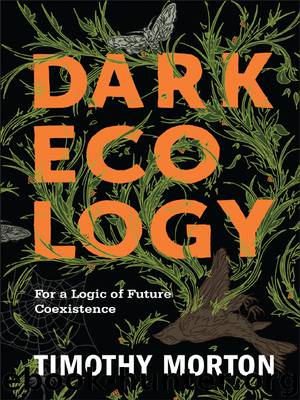Dark Ecology: For a Logic of Future Coexistence by Morton Timothy

Author:Morton, Timothy
Language: eng
Format: epub
Tags: PHI040000, Philosophy/Movements/Critical Theory, NAT010000, Nature/Ecology
Publisher: Columbia University Press
Published: 2016-04-18T16:00:00+00:00
Narcissistic stones. Awareness of ourselves as another “nonhuman” entity has to do with our knowledge, now including logical proofs, that even our thoughts and logical systems evade us. Despite our intentions, they have a life of their own, which means, despite our fantasies that they are totally coherent, they are in fact fragile, like lifeforms. To be a logical system is to be able to speak nonsense because to be a thing is to be nonsensical. Ecognosis has to do with allowing for this nonsensical, pestiferous dimension of things. A thought, a lizard, a spoon veer from themselves. To be a thing is to be a deviation. A thing, a thought, a sentence are per-ver-se. An en-vir-onment is not a closed circle but a veering loop.65 A thing is in a loop with itself: a thing and a thing-pattern, asymmetrical, which is why there can be patterns at all—which is why there can be replication. Which is why there can be organic chemicals, lifeforms, and sentences about patterns.
Some physicists are now arguing that once patterns are possible lifeforms are not far behind. Some geneticists are now beginning to suspect that life is far more basic to the universe than previously thought. If one extrapolates the data backward, it might be the case that life arose close to the origin of the Milky Way Galaxy and the universe, 13.75 billion years ago.66 At any rate, the process might well be far less contingent than “dead matter” ontologies allow for.67 Patterns minimize energy throughput because, as Freud points out, the purpose of life is death. Death—dissipated energy—is what replicants are aiming for in a dance that Arthur Schopenhauer might have recognized. Patterns are how they aim for it. Patterns, in a sense, are the death drive, and beauty is death, a thought common to decadent aesthetes denigrated on all sides for their refusal to buy into “progress” and the yang culture of affirmation and “just do it.” Patterns outlast the lifeforms that they give rise to. Stromatolites, fossil records of single-celled organisms, are a case in point. A patterned, bubbly rock found on an alien planet such as Mars may or may not be evidence of lifeforms as such.68 Patterns logically precede life just as they precede truth.
There is something profound and perhaps disturbing about the aesthetic-causal dimension. And about life: “life” is not the opposite of death. The homology between cancer cells and embryo growth bears this out. The only difference is that an embryo becomes shapely through another death process, apoptosis: the dying away of superfluous cells. There is no final resting spot: the pattern is always excessive.69 Life is an ambiguous spectral “undead” quivering between two types of death: the machination of the death drive and the dissolution of physical objects.
Easy Think Substance theory asserts that lumps of whateverness are logically prior to appearances: in order for appearance to happen there must be bland extension lumps from which those appearances can arise. If you put it that way you can see the paradox.
Download
This site does not store any files on its server. We only index and link to content provided by other sites. Please contact the content providers to delete copyright contents if any and email us, we'll remove relevant links or contents immediately.
The Lonely City by Olivia Laing(4768)
Animal Frequency by Melissa Alvarez(4428)
All Creatures Great and Small by James Herriot(4271)
Walking by Henry David Thoreau(3923)
Exit West by Mohsin Hamid(3795)
Origin Story: A Big History of Everything by David Christian(3666)
COSMOS by Carl Sagan(3589)
How to Read Water: Clues and Patterns from Puddles to the Sea (Natural Navigation) by Tristan Gooley(3433)
Hedgerow by John Wright(3317)
How to Read Nature by Tristan Gooley(3292)
The Inner Life of Animals by Peter Wohlleben(3285)
How to Do Nothing by Jenny Odell(3264)
Project Animal Farm: An Accidental Journey into the Secret World of Farming and the Truth About Our Food by Sonia Faruqi(3189)
Origin Story by David Christian(3170)
Water by Ian Miller(3155)
A Forest Journey by John Perlin(3043)
The Plant Messiah by Carlos Magdalena(2900)
A Wilder Time by William E. Glassley(2835)
Forests: A Very Short Introduction by Jaboury Ghazoul(2815)
